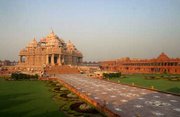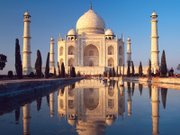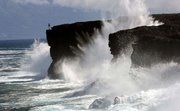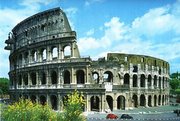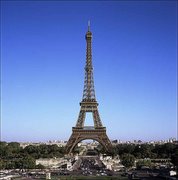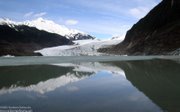Holland, or the Netherlands as it is officially known, is a very bicycle-friendly country. The way that cycling is included in the traffic systems, the general small scale of everything and the flat terrain all contribute greatly in providing the perfect conditions for a stress-free tour.To help you choose your own cycling holiday, Tulip Cycling has selected five themes representing the best of Holland on a cycling holiday. Choose your favourite theme(s), then add your own special interests. Our route-planners will do the rest, creating your individual bike tour. Rest assured that you won't be bored, - there is so much to discover!
Country The country is flat and has a unique infrastructure that includes 20,000 kilometres (12,000 miles) of specially designated cycling lanes and paths. Within a one-day cycling trip (20-40 miles) you will pedal your way through different types of landscapes, each with its own cultural and historical characteristics. The climate is moderate with April-September temperatures between 15 and 30 degrees Celsius (60-90 F).
The country is flat and has a unique infrastructure that includes 20,000 kilometres (12,000 miles) of specially designated cycling lanes and paths. Within a one-day cycling trip (20-40 miles) you will pedal your way through different types of landscapes, each with its own cultural and historical characteristics. The climate is moderate with April-September temperatures between 15 and 30 degrees Celsius (60-90 F).  The bicycle is a familiar day-to-day sight in Holland. Traffic systems are adapted to take account of cyclists and are supported by a comprehensive system of road signs. Biking is very safe; even young children commute to school by bike. The friendly and multilingual Dutch are always ready to show off their country and to share their paths with fellow cyclists. You will be surprised at the amount of consideration motorists give to cyclists. And the reason why? It is because most of them are cyclists themselves!
The bicycle is a familiar day-to-day sight in Holland. Traffic systems are adapted to take account of cyclists and are supported by a comprehensive system of road signs. Biking is very safe; even young children commute to school by bike. The friendly and multilingual Dutch are always ready to show off their country and to share their paths with fellow cyclists. You will be surprised at the amount of consideration motorists give to cyclists. And the reason why? It is because most of them are cyclists themselves!
The country is bordering the North Sea and is situated between Belgium and Germany.
The Tulip Cycling base station is located at the centre of Holland, in Houten, just south of Utrecht. It is only 40 minutes from Amsterdam, 45 minutes from Amsterdam Schiphol airport and 90 minutes from the UK ferry terminals Hook of Holland, Europoort and IJmuiden It is a good starting point for most tours, although we can also arrange your tour start or finish at any other place that may be more convenient.
Themes
The five themes that Tulip Cycling has created are designed to show off the best of Holland,and to help you choose your ideal route.
North Sea coast The western coastline of The Netherlands is 300 kilometres (180 miles) long and a unique stretch of sand and dunes. The beaches stretch from the Wadden Islands in the north, to the Belgian coast in the south, with only the odd river or harbour interrupting the coastline. It is characterized by its long, broad beaches, bordered by smooth, wind-blown dunes just behind. The coastal regions boast their own special characteristics with their little seaside resort towns and villages, lighthouses and the wild, natural beauty of the almost unbroken lines of dunes.
The western coastline of The Netherlands is 300 kilometres (180 miles) long and a unique stretch of sand and dunes. The beaches stretch from the Wadden Islands in the north, to the Belgian coast in the south, with only the odd river or harbour interrupting the coastline. It is characterized by its long, broad beaches, bordered by smooth, wind-blown dunes just behind. The coastal regions boast their own special characteristics with their little seaside resort towns and villages, lighthouses and the wild, natural beauty of the almost unbroken lines of dunes.
If you're looking for crowds, you will find them on the beach on a hot summer day. But if you're looking for peace and quiet, there's plenty of that too. The beach stretches for many miles and offers anonymity even during the busiest hours. Just off the coast, many attractions, museums and events are easily accessible by bike. There is even a virtually uninterrupted bicycle path, leading from the northern town of Den Helder to Rotterdam. The Springtime is a special time of the year to cycle along the North Sea coast on account of the breathtaking views of the bulb fields. Between the beginning of April and the middle of May, the famous Dutch bulb fields are at their best, providing a dramatic display of tulips, hyacinths, and daffodils for mile after mile, and in all the colours of the rainbow. The prime growing region lies between Haarlem and Leiden, just 10 kilometres from the coast.
The Springtime is a special time of the year to cycle along the North Sea coast on account of the breathtaking views of the bulb fields. Between the beginning of April and the middle of May, the famous Dutch bulb fields are at their best, providing a dramatic display of tulips, hyacinths, and daffodils for mile after mile, and in all the colours of the rainbow. The prime growing region lies between Haarlem and Leiden, just 10 kilometres from the coast.
Combine this tour option with a visit to the famous 'Keukenhof' spring gardens and perhaps you could also visit the large 180 degree landscape painting at the 'Panorama Tulipland'. If you choose the 'North Sea coast' theme during this period, then the bulb field bicycle route will be included in your trip.
Windmills & Waterways The name 'The Netherlands' actually means 'the lowlands'. Long, long ago, much of Holland was covered in water, but over the centuries the land has gradually been reclaimed from the sea. The Dutch coastline is determined principally by dunes and man-made water walls called dykes. Together they protect the low-lying parts (polders) of the country against the North Sea.
The name 'The Netherlands' actually means 'the lowlands'. Long, long ago, much of Holland was covered in water, but over the centuries the land has gradually been reclaimed from the sea. The Dutch coastline is determined principally by dunes and man-made water walls called dykes. Together they protect the low-lying parts (polders) of the country against the North Sea.
Approximately a third of the entire country lies below sea level, and only in the south-eastern province of Limburg will you find hills. The Rhine is the major river and consists of the melt-water from the mountains of Germany and Switzerland and spills out over the flatlands of Holland. The result is an impressive lowlands landscape, laced with canals and punctuated by quaint tile-roofed villages.  Dutch water-engineering is impressive. Water from the low-lying polders is drained by a network of canals, slow flowing rivers and sluices and is finally pumped away by modern pumping stations, or sometimes older steam-pumps, or even by the famous old Dutch windmills. There are more than 1,000 windmills which have been well preserved and are still in good working order. It is possible to visit some of these windmills on your tour.
Dutch water-engineering is impressive. Water from the low-lying polders is drained by a network of canals, slow flowing rivers and sluices and is finally pumped away by modern pumping stations, or sometimes older steam-pumps, or even by the famous old Dutch windmills. There are more than 1,000 windmills which have been well preserved and are still in good working order. It is possible to visit some of these windmills on your tour.
National park The largest national park is situated in the central-eastern part of the country, near the town of Apeldoorn. It is called the Hoge Veluwe, and the origins of the area were formed some 200,000 years ago when the glaciers pushed up layers of soil creating huge banks, the so-called 'stuwwallen'.
The largest national park is situated in the central-eastern part of the country, near the town of Apeldoorn. It is called the Hoge Veluwe, and the origins of the area were formed some 200,000 years ago when the glaciers pushed up layers of soil creating huge banks, the so-called 'stuwwallen'.
Gradually strong winds some 10,000 years ago covered the banks with sand. Today the park has an area of 5,500 hectares and is a unique blend of forests and woods, shifting sands and heather moor lands providing a sense of isolation that is not to be found elsewhere on the mainland of The Netherlands. Red deer, wild boar and wild sheep roam freely. The Hoge Veluwe has a recently renovated Visitors Centre, as well as the beautiful and architecturally significant Hunting Lodge called St Hubertus. The gem of the park must be the famous Kröller-Müller Museum, containing 278 works by Van Gogh, as well as smaller collections of Picasso and Mondriaan and many others. Around the museum building and in the enchanting gardens is Europe's largest collection of sculpture with works by Rodin, Moore, Giacometti and many more.The park is traversed by many cycle paths and there is almost no vehicular traffic.
The Hoge Veluwe has a recently renovated Visitors Centre, as well as the beautiful and architecturally significant Hunting Lodge called St Hubertus. The gem of the park must be the famous Kröller-Müller Museum, containing 278 works by Van Gogh, as well as smaller collections of Picasso and Mondriaan and many others. Around the museum building and in the enchanting gardens is Europe's largest collection of sculpture with works by Rodin, Moore, Giacometti and many more.The park is traversed by many cycle paths and there is almost no vehicular traffic.
.
Historical cities
The history of the old Dutch cities is very interesting. Sometimes originating from outposts of the Roman army, they have survived floods, fires, wars, and it has to said - modern architecture.
Despite a lack of building materials and swamp conditions, the merchants of the sixteenth century managed to amass unbelievable fortunes, building beautiful mansions with lavish interiors. The wealthier merchants commissioned artists to paint their portraits and so the famous Dutch School developed. Rembrandt van Rijn, Johannes Vermeer and Frans Hals to name but a few all belonged to this school. The Dutch artisans making ceramic pottery also found a ready market for their products. This period of prosperity became known as the Golden Age. Today the famous period is still evident in some smaller Dutch cities such as Delft, Gouda and Leiden, as well as in the four proud main cities: Amsterdam, The Hague, Rotterdam and Utrecht.
The Dutch artisans making ceramic pottery also found a ready market for their products. This period of prosperity became known as the Golden Age. Today the famous period is still evident in some smaller Dutch cities such as Delft, Gouda and Leiden, as well as in the four proud main cities: Amsterdam, The Hague, Rotterdam and Utrecht. Amsterdam is famous for the Rijksmuseum, the Van Gogh Museum, Anne Frank house, its beautiful canals and of course, its vibrant atmosphere. We recommend that you visit the city before or after your cycle tour, taking public transport (train and tram). The level of traffic and the amount of people milling about the narrow streets would not add to your cycling pleasure.
Amsterdam is famous for the Rijksmuseum, the Van Gogh Museum, Anne Frank house, its beautiful canals and of course, its vibrant atmosphere. We recommend that you visit the city before or after your cycle tour, taking public transport (train and tram). The level of traffic and the amount of people milling about the narrow streets would not add to your cycling pleasure.
The Hague on the other hand is solemn and distinguished and famous for its royal palaces and parliament buildings. In Utrecht you should explore the city's canal structure and the unusual pedestrian wharfs, lying five meters below street level.  Delft owes its name to the world 'delving', digging the oldest canal. The city links to appealing cultural-historical values such as Delftware, the Dutch royal family and the Dutch East India Company. From Delft you can easily visit Rotterdam. This city was badly bombed during WWII, but has resurrected itself to become an icon of experimental post-war architecture, as well as being the biggest commercial harbour of the world.
Delft owes its name to the world 'delving', digging the oldest canal. The city links to appealing cultural-historical values such as Delftware, the Dutch royal family and the Dutch East India Company. From Delft you can easily visit Rotterdam. This city was badly bombed during WWII, but has resurrected itself to become an icon of experimental post-war architecture, as well as being the biggest commercial harbour of the world.
There are really countless places that will be of interest to you. Town and villages, each with their own personality and uniqueness and of course many, many museums, parks etc.
World War II reflection
 The Netherlands was able to stay neutral through World War I but couldn't exercise the same privilege in the Second World War. On May 10, 1940 the Germans invaded by crossing the Eastern border. On May 15 capitulation was signed after a German bombing blitz on Rotterdam, which destroyed most of the city. During the years 1940-1944 the Dutch suffered under the oppression of the German occupier. Although a sound Dutch resistance movement was formed, numerous Jews were deported to concentration camps and never returned. Many Dutch men were forced to hard labor in German war industries.
The Netherlands was able to stay neutral through World War I but couldn't exercise the same privilege in the Second World War. On May 10, 1940 the Germans invaded by crossing the Eastern border. On May 15 capitulation was signed after a German bombing blitz on Rotterdam, which destroyed most of the city. During the years 1940-1944 the Dutch suffered under the oppression of the German occupier. Although a sound Dutch resistance movement was formed, numerous Jews were deported to concentration camps and never returned. Many Dutch men were forced to hard labor in German war industries. After the successful Allied invasion (D-day) in Normandy, the south of Holland was liberated in the summer of 1944. The Allies developed a paratrooper plan, Market Garden, to seize two bridges in Holland: one at Nijmegen and the other at Arnhem. The first objective was reached, but the second was a disaster. The paratroopers were decimated by a German Panzer division, the survivors eventually escaped back to the Allied lines. The first months of 1945 were extremely costly to the Dutch. Thousands of people died of starvation in the cities, where the effects of shrinking food supplies were the most severe.
After the successful Allied invasion (D-day) in Normandy, the south of Holland was liberated in the summer of 1944. The Allies developed a paratrooper plan, Market Garden, to seize two bridges in Holland: one at Nijmegen and the other at Arnhem. The first objective was reached, but the second was a disaster. The paratroopers were decimated by a German Panzer division, the survivors eventually escaped back to the Allied lines. The first months of 1945 were extremely costly to the Dutch. Thousands of people died of starvation in the cities, where the effects of shrinking food supplies were the most severe. Finally, in April 1945 the Allied forces were able to push through and Holland was liberated on May 5; three days before Germany's total surrender. With the arrival of freedom, the Dutch went from the depth of despair to soaring heights of joy. Experiences from WW II are engraved in the collective Dutch consciousness. This manifests itself in a day (May 4) of commemoration of all military and civil victims of war and the remembrance of the tremendous sacrifice of the foreign Allied liberation force.
Finally, in April 1945 the Allied forces were able to push through and Holland was liberated on May 5; three days before Germany's total surrender. With the arrival of freedom, the Dutch went from the depth of despair to soaring heights of joy. Experiences from WW II are engraved in the collective Dutch consciousness. This manifests itself in a day (May 4) of commemoration of all military and civil victims of war and the remembrance of the tremendous sacrifice of the foreign Allied liberation force.Each year the end of World War II is celebrated on 'Liberation Day' on the 5th of May. The events and emotions of the dark years of the WWII period are well preserved in many museums, visitors centres and war cemeteries. Their purpose is to show the horrors of that period in the hope that 'this never again' will happen to future generations. Some major battle fields from 1940 and also the area where the 'Market Garden' operation took place are all within easy cycling distance, so that you may wish to include this theme along with your other preferences.
Routes
 The most scenic and the safest routes form an important part of your cycling tour. Your Tulip Cycling itinerary is based on our route manager's extensive knowledge of the Dutch cycling lane and path infrastructure. We will guide you along the small, paved back roads of Holland, many of which are unknown to the majority of cyclists! There are plenty of opportunities en route to stop and take a rest at the many restaurants, cafe terraces or the designated picnic areas.
The most scenic and the safest routes form an important part of your cycling tour. Your Tulip Cycling itinerary is based on our route manager's extensive knowledge of the Dutch cycling lane and path infrastructure. We will guide you along the small, paved back roads of Holland, many of which are unknown to the majority of cyclists! There are plenty of opportunities en route to stop and take a rest at the many restaurants, cafe terraces or the designated picnic areas.  Our unique route support system uses a combination of GPS and a laminated cycling map. The GPS gives your exact position on the route at any given time, while the detailed cycling map (scale 1:75,000) gives a complete overview of the route. Go to the "Equipment & Support" page for more information about this system. The route lengths vary according to each of the three different levels: beginners (20m/35km) - intermediate (30m/50km) - experienced (40m/65km).
Our unique route support system uses a combination of GPS and a laminated cycling map. The GPS gives your exact position on the route at any given time, while the detailed cycling map (scale 1:75,000) gives a complete overview of the route. Go to the "Equipment & Support" page for more information about this system. The route lengths vary according to each of the three different levels: beginners (20m/35km) - intermediate (30m/50km) - experienced (40m/65km).








